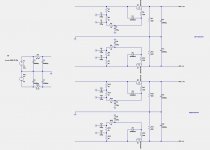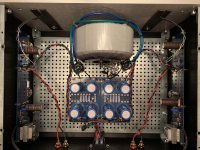It will give you around 4 to 5 volt drop, if you need more than that and have enough heatsinking then probably go regulated
Thank you, 6L6 and Zen Mod, for your quick responses. That is very reassuring. I am leaning toward the 18 volts. I could always use Babysitter as a backup in the event I need further cooling.
When I get home I can post a circuit.
Did you ever make it back home?
Did you ever make it back home?
LOL
Yeah, got busy.
I will do it now.
Did you ever make it back home?
For stereo do like this.
One cap multiplier per channel fed from CCRCC supply.
Attachments
If you wanted you could replace 1k-220uF-1k-220uF-1k-220uF with:
A single but larger cap like this, 1k-2200uF
A single but larger cap like this, 1k-2200uF
Last edited:
If you wanted you could replace 1k-220uF-1k-220uF-1k-220uF with:
A single but larger cap like this, 1k-2200uF
This is interesting! I have a nice toroidal power transformer with four secondaries that needs to find a project but the secondary voltage was too high for the F6 project. I began with the idea that I'd do a choke input supply to drop the voltage but then the concept of power supply resonance and came up and worried me so I bought a pair of Toroidy transformers with the voltage that the F6 needs and moved on. This gives me some more options for the other transformer. Thanks!
No worries.
It's worth doing.
If you have 4 secondaries then add another ccrcc supply, ie one driving each cap multiplier for dual mono supply.
It's worth doing.
If you have 4 secondaries then add another ccrcc supply, ie one driving each cap multiplier for dual mono supply.
What do the Mosfets need for heat sinking in this circuit?
A big case, typically a 4U size (from the store.)
The F6 amp is capable of running in the same power range as an M2, or considerably higher as I did with mine. The size of the case will need to match the power dissipation. The standard 18V + 18V transformer will produce similar power to an M2, and a 3U, 400mm deep case will suffice for this.
Power rail voltages of 26V to 27V and high bias current are manageable with a 4U, 400mm deep case size. Try IRFP150 or FQH44N10 Mosfets.
Power rail voltages of 26V to 27V and high bias current are manageable with a 4U, 400mm deep case size. Try IRFP150 or FQH44N10 Mosfets.
A big case, typically a 4U size (from the store.)
Sorry, I meant for the capacitance multiplier circuit in post 1668.
Mosfets used in a cap multiplier may dissipate 5 or 6 Watts, depending on the bias current. Think 4+ Volts drop from Drain to Source times the current.
Good idea!
Have you figured what switches you will use?
nash
Yes, sorry just saw this. Got them on Amazon.
https://www.amazon.com/gp/product/B07QJ2FTV7/ref=ppx_yo_dt_b_asin_title_o00_s00?ie=UTF8&psc=1
Russellc
Sorry, I meant for the capacitance multiplier circuit in post 1668.
P=VI
To keep the calculation simple and be on the conservative side in terms of heat dissipation let's just say the Vdrop is 5V.
Current, (I) will be the bias of one channel.
At 1.3A Bias P = 5 x 1.3 = 6.5 Watts on each mosfet.
It will be less than this but it's always good to over engineer a little bit with regards to heatsinking.
Last edited:
F-6 Disaster - Help please.
I have been a grateful recipient of the accumulated advice and wisdom of this site and this thread particularly. I was an early buyer of the F6 kit and even with my very limited understanding of the reasons why everything works was able to assemble this amazing amp from the instructions here. It's been running beautifully for about three years.
Yesterday, after fiddling with my speaker wiring I did not have power to my surge protector and this amp, pre, TT etc. When I pushed the plug into this aged and loose receptacle, there was an arc at the plug and then that really bad smell. Amp and Pre both damaged. Surge protector fuse open, but not fast enough apparently.
Taking off the cover I see a big exposed trace on the left board, the CL-60 at the main ground has exploded.
I am asking for advice on how to proceed to repair. Start with new boards and probably new transistors? Are the Jensen transformers likely to be OK?
PSU? Photo of my layout is attached if that is of any help.
Any advice is greatly appreciated. Thanks.
I have been a grateful recipient of the accumulated advice and wisdom of this site and this thread particularly. I was an early buyer of the F6 kit and even with my very limited understanding of the reasons why everything works was able to assemble this amazing amp from the instructions here. It's been running beautifully for about three years.
Yesterday, after fiddling with my speaker wiring I did not have power to my surge protector and this amp, pre, TT etc. When I pushed the plug into this aged and loose receptacle, there was an arc at the plug and then that really bad smell. Amp and Pre both damaged. Surge protector fuse open, but not fast enough apparently.
Taking off the cover I see a big exposed trace on the left board, the CL-60 at the main ground has exploded.
I am asking for advice on how to proceed to repair. Start with new boards and probably new transistors? Are the Jensen transformers likely to be OK?
PSU? Photo of my layout is attached if that is of any help.
Any advice is greatly appreciated. Thanks.
Attachments
hi - i have been discussing the danger of using a thermistor in this circuit on a separate thread. I am very sorry that this has happened but members who are qualified with these things (I am not one of them) knew the risks but unfortunately no one has (probably because of the nature of the forum), tells all the other members about this. It could have been much worse. My only suggestion is to pause and make sure that the circuit schema is fixed properly before proceeding with any repair. Unfortunately, if no solution is found, it's a dangerous circuit to use and sooner or later, someone will end up dead.
Didn't the CL60 do it's job in this example? I thought it's purpose is to tamp down an excessive current inrush on start up - I could be wrong though
Use this one, MS22 20005 Ametherm | Circuit Protection | DigiKey
Much more robust, I have been using them for a while.
They are excellent.
Much more robust, I have been using them for a while.
They are excellent.
- Home
- Amplifiers
- Pass Labs
- F6 Illustrated Build Guide

